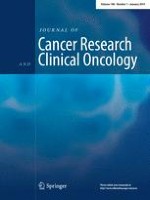Published in:

01-10-2004 | Original Paper
Effects of the angiotensin-I converting enzyme inhibitor perindopril on tumor growth and angiogenesis in head and neck squamous cell carcinoma cells
Authors:
Ryuji Yasumatsu, Torahiko Nakashima, Muneyuki Masuda, Aya Ito, Yuichiro Kuratomi, Takashi Nakagawa, Shizuo Komune
Published in:
Journal of Cancer Research and Clinical Oncology
|
Issue 10/2004
Login to get access
Abstract
Purpose
Recently, it has been reported that angiotensin-I converting enzyme (ACE) inhibitors have anticancer activity. In particular, the ACE inhibitor, perindopril, significantly inhibits tumor growth and angiogenesis in hepatocellular carcinoma cells along with suppression of the VEGF level. However, the mechanisms of suppression of the VEGF level are still unclear, and there are no previous reports on this subject related to head and neck squamous cell carcinoma (HNSCC). In some previous studies, angiotensin II, which is produced from angiotensin I by ACE, directly stimulates VEGF expression.
Methods
In the present study, we focused upon angiotensin II, and investigated the effect of perindopril on VEGF expression, angiogenesis, and tumor development of HNSCC with in vitro and in vivo studies.
Results
In the in vitro cell proliferation assays, there was no significant difference between the perindopril-treated group and the control group. However, the perindoprilat-treated group showed a significant reduction in mRNA expression of VEGF and inhibited the induction activity of the VEGF promoter in comparison to the control group. Perindoprilat treatment also significantly suppressed angiotensin II production in vitro. In the in vivo studies, perindopril had a significant inhibitory effect on tumor growth, and reduced blood vessel formation surrounding the tumors.
Conclusions
Our findings suggest that perindopril has no direct cytotoxicity against tumor cells, but has a potential to inhibit tumor growth due to suppression of VEGF-induced angiogenesis in vivo. Angiotensin II might have an important role in carcinogenesis, and the antiangiogenic activity of perindopril is at least partly mediated by angiotensin II inhibition. The ACE inhibitor perindopril has clinical potential as a useful antitumor agent.





